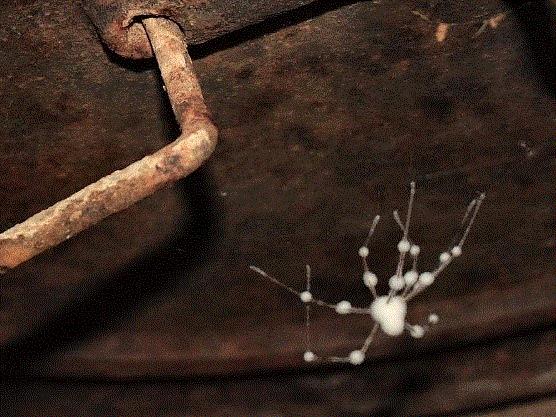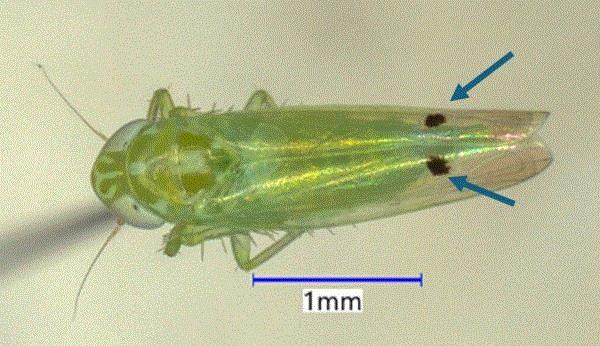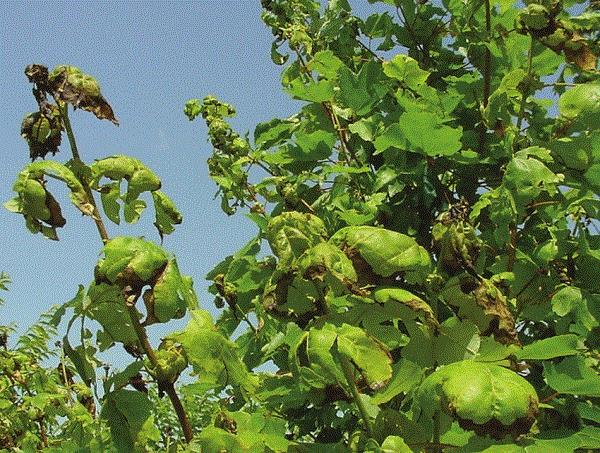What the ... ?
A couple of weeks ago, Tim Boyle (plant pest and disease specialist at the Wisconsin Department of Agriculture Resource Management) and I were email chit-chatting about BioPhyter and Beauveria bassiana (which I posted about a month ago). Tim shared a picture of a golden silk orb-weaver spider killed by Beauveria bassiana.
Better yet, Tim shared a story about him and his buddies coming across some fuzzy spiders in long abandoned service tunnels in Minnesota many years ago. (“Exploring spooky places, eh? Do tell!”) Tim wondered if those fuzzy spiders were infected with Beauveria bassiana. Were they?

What made this cellar spider fuzzy? (Photo credit: Tim Boyle, Wisconsin Department of Agriculture Resource Management.)
Those spiders are pretty wild! They look just like some kind of snowball. They remind me of something from a younger age … That’s right—those soot balls (susuwatari) in the anime movie "Spirited Away"! Only that these ain’t moving.
My experience with these fuzzy spiders is limited since I don’t explore abandoned buildings and service tunnels. And I haven’t seen any of these fuzzy or zombie spiders in the crawlspace under my house. (Well, the truth is I haven’t really looked because I try to get out of the crawlspace as soon as I’m done with what I’m supposed to do down there. Y’all wouldn't dilly-dally either if you had to crawl on your stomach, knowing you can’t turn or back out very fast, and don’t know when the next snake will jump at you.)

Two-Spot Cotton Leafhopper on Ornamental Plants
Here's an invasive species that I failed to pay attention to: the two-spot cotton leafhopper (TSCL). Why? Well, its common name made me think it mainly affects cotton, which it does. I would have remained ignorant of it if it hadn’t caused issues on hibiscus in Florida and Texas.
Last Friday, I attended a webinar on the status of the two-spot cotton leafhopper in Texas. The webinar was given by Rafia Khan of Texas A&M University and hosted by the Texas Nursery & Landscape Association (TNLA). We have lots of leafhopper species in both field and container nurseries, such as the potato leafhopper, but this species is a new one. I thought I should try to learn something about it as part of my continuing education.
Let me share what I've learned about this invasive species with you.
The two-spot cotton leafhopper, AKA the cotton jassid, originates from a wide area in Asia, stretching from Iran to Japan and south to Indonesia. The first detection of this species in the Western Hemisphere was made in the U.S. Virgin Islands and Puerto Rico in 2023. Then it spread through the Caribbean and arrived in Florida in 2024. Now it’s also found in Alabama, Georgia, South Carolina and Texas.
Infested hibiscus plants had been found in retail outlets in Louisiana, according to the National Cotton Council, but field establishment hasn’t been confirmed. Hibiscus plants in some retail gardens in southern Texas were found infested and these hibiscus plants were traced to a single out-of-state supplier according to TNLA.

An adult two-spot cotton leafhopper (AKA cotton jassid). The two black spots at the end of wings are a good diagnostic characteristic for this invasive species. (Photo credit: Issac Eaquivel, University of Florida.)
The two-spot cotton leafhopper has attracted a lot of attention because it causes damage to cotton, with the potential to significantly reduce yield. It also attacks a long list of plant species, mainly from the plant families Malvaceae (cotton, okra, hibiscus, etc.), Fabaceae (peanut, soybean, mung bean, cowpea, etc.), Asteraceae (sunflower, etc.) and Solanaceae (eggplant, potato, etc.).

Hopperburn on hibiscus caused by the two-spot cotton leafhopper. (Photo credit: Alondra Vieves, University of Puerto Rico at Mayaguez.)
The major damage caused by the two-spot cotton leafhopper is hopperburn, very much like those caused by the potato leafhoppers on red maple. Leaves of the infested plants become distorted, chlorotic and necrotic.
Go HERE for information on this species and pictures of damage on various crops. There are reports from India that the two-spot cotton leafhopper vectors phytoplasma, but those reports haven’t been substantiated.

Identification and Biology of TSCL
Y’all may see hopperburn on plants before you notice the insects because leafhoppers (of any species) are small, feed on the underside of leaves and only move when disturbed. Nymphs aren’t particularly useful in field identification because the nymphs of the two-spot cotton leafhopper look almost identical to nymphs of other leafhopper species.
Rafia mentioned that the nymphs of the two-spot cotton leafhopper move rapidly in a side-way or crab-like motion when disturbed. I don’t know about that … I saw the nymphs moved more or less erratically. I’ve also seen this kind of motion displayed by nymphs of other leafhopper species, such as the potato leafhopper. Maybe folks with better eyes can use this behavior as a diagnostic characteristic.
Adults are a bit easier to identify—adults have two black spots near the end of their wings. In some individuals, they also have tiny black dots on the front of their heads. Adults of other leafhopper species, such as the potato leafhopper, may have green bodies, but no dark spots on the wings. Other species, such as the sycamore leafhopper, may have spots or dark patches on the wings, but are of different colors or patterns on the rest of their bodies.
Go HERE for a diagnostic guide with a comparison of the two-spot cotton leafhopper adults with adults of other look-alike leafhopper species.

From left to right: A two-spot cotton leafhopper, a potato leafhopper and a sycamore leafhopper. I wonder what kind of mess they create when they walk into a bar ...? (Photo credit: Daphne Zapsas, USDA; Dann Thombs @ flickr; Joe MDO @ iNaturalist.)
According to Rafia, data and observations from other areas suggest that multiple generations of the two-spot cotton leafhoppers may be present throughout the year (unlike the potato leafhopper, see the next section). The peak population is likely to occur in the summer because the optimal temperature for the species ranges from 81 to 93F.
Being a polyphagous species (i.e. one that can feed on many host plant species), the two-spot cotton leafhopper can switch from one host to another depending on season and host availability. I can already see the potential of increased damage of nursery plants from this species when it builds a population in a nearby cotton field and invades the nurseries when the cotton crop is defoliated or harvested.

Monitoring and Management of TSCL
There’s no solid monitoring or management information available for ornamental plant producers and managers because the two-spot cotton leafhopper is a newcomer. Information is being generated in cotton crops and may be insightful for us.
Known host plants, particularly hibiscus, showing symptoms of foliar chlorosis should be inspected to see if adults, nymphs or shed skins can be found on the underside of leaves. (Y’all really should start looking before chlorosis becomes full-blown hopperburn.) You can also use sticky cards to monitor the leafhopper’s presence and population growth; the two dark spots on adults make this species relatively easy to identify.

Adult two-spot cotton leafhoppers trapped on a yellow sticky card (circled in red). The two black spots on the wings make it easy to identify this species. (Photo credit: Paul Langlois, USDA.)
Leafhoppers can also be collected by bagging the infested plants or via beat sampling. (See pictures of how bagging and beat sampling works by going HERE.) The leafhoppers should be submitted for expert identification. Why do we need to involve the experts? Because leafhopper species can only be confirmed by examining male genitalia. Not sure this is a job any Joe Schmo can do proficiently (or would want to do for that matter).
Keeping plants healthy with proper growing, fertilization and irrigation practices can help alleviate stress and tolerate leafhopper infestation. Removing unwanted plants or weeds around the nurseries can also reduce refuge and sources of population for the leafhoppers. Growers with nurseries that are surrounded by fields of susceptible hosts (such as cotton, okra and other crops) may want to consider relocating their hibiscus plants further away and upwind from these crop fields.
Although many natural enemies have been documented in the field, a commercially available macro-biocontrol agent isn’t available. The efficacy of entomopathogenic fungi and bacteria against the two-spot cotton leafhopper remains to be determined.
Studies in the cotton system suggest that bifenthrin (e.g., Talstar and many generics), thiamethoxam (e.g., Flagship), flupyradifurone (e.g., Altus), flonicamid (e.g., Aria), afidopyropen (e.g., Ventigra), buprofezin (e.g., Talus) and sulfoxaflor + spinetoram (e.g., XXpire) are effective, according to a post by Shimat Joseph of the University of Georgia. Rafia added imidacloprid (e.g., Marathon and many generics) and dinotefuran (e.g., Safari) to the list during the seminar. I provided the insecticide trade names here just in case you aren’t familiar with the active ingredient names.
Again, I must say that the data were generated in a different crop system using insecticides of different trade names (and, therefore, likely different formulations and application rates than the ones named above). This information can only serve as general guidance right now. Hopefully, more studies will be conducted in ornamental systems to generate relevant management information soon.
At this time, no regulatory or quarantine action has been imposed by federal and state authorities. Everyone is encouraged to report sightings of two-spot cotton leafhopper, especially on hibiscus, to the extension service or state departments of agriculture.

Speaking of Leafhoppers and Hopperburn
Let’s play a guessing game to close this week’s issue of PestTalks. How many species of leafhoppers do you think there are? (Here's a hint: You know there are more insect species than plant species, so go high.) 500? 1,000? 1,500?
Estimating conservatively, there are close to 3,000 leafhopper species in North America alone. Worldwide, we’re looking at over 23,000 species. Some estimates go as high as more than 100,000 species worldwide. The tropics is a hot bed of leafhopper diversity. The fact is even more amazing considering that I’m only strictly talking about one family, Cicadellidae, or the true leafhoppers. I didn’t include all the other planthoppers, treehoppers, froghoppers, spittlebugs, etc.
The two-spot cotton leafhopper, potato leafhopper and sycamore leafhopper I mentioned above are but three of the most common and noticeable species. There are many more species feeding on ornamental plants both in production and in landscapes, but most of them don’t cause any damage. I regularly find aster leafhoppers on vegetables and herbs (such as tomato and sage), flowering plants (such as marigold and zinnia) and weeds (such as dandelion and thistle). I also find glassy-winged sharpshooters on crape myrtles often. There are many other species.
Potato leafhopper is by far the most significant leafhopper pest in nursery production because of its ability to cause hopperburn on many tree and shrub species. It seems to me that this pest “fell out of favor” for a little bit. The more relaxed attitude is understandable because the potato leafhopper isn’t difficult to control if you can catch them coming into the nursery and make insecticide applications on time. But if invitations for me to talk about the potato leafhopper in the past couple of years are any guide, maybe folks are beginning to see the cost of taking their eyes off the ball and want to learn more about this resurging pest.
To me, the keys to managing potato leafhoppers is to monitor the influx of adults into nurseries, and make insecticide applications to kill them and prevent damage. Potato leafhoppers don’t overwinter in most states, so there are periods of time when nurseries aren’t facing an onslaught of leafhoppers. They overwinter in the warmer Gulf Coast states, and resume reproduction as spring arrives and deepens. Individuals migrate north, mainly by being carried in the wind, as northerly areas warm up. Many southern states see an active leafhopper influx in May and the more northerly states as late as August.
Hopperburn is the major damage caused by the potato leafhopper. It’s pretty hard to diagnose because the symptoms can be so similar to heat stress, sun or salt burn, or herbicide injury. Only after you flip over the leaves and see the nymphs, adults or shed skin under the leaves can you make a more educated diagnosis.

Hopperburn on maple. (Photo credit: Amy Fulcher, The University of Tennessee.)
Although the two-spot cotton leafhopper isn’t known to transmit diseases, other leafhopper species are effective disease vectors. For example, the aster leafhopper is a vector of aster yellows phytoplasma. The glassy-winged sharpshooter is feared by Californian grape producers because of its ability to transmit the bacterium Xylella fastidiosa, which leads to Pierce’s disease in grapes (as well as phoney peach disease and citrus X disease elsewhere).
For a long time, folks thought hopperburn was a manifestation of some diseases or biotic agents. When a pathogen couldn’t be consistently associated with hopperburn, other causal agents were proposed, such as the leafhopper’s saliva itself or some enzymes or toxins in the saliva. A review paper by Elaine Buckus of USDA-ARS and her colleagues convincingly argued that hopperburn by the potato leafhopper and its congeneric cousins is the result of an interaction between how leafhoppers feed and how plants respond to the injury. The leafhoppers feed by rupturing cells and the injection of saliva (a toxin isn’t involved here) causes a series of plant wound responses that eventually lead to hopperburn. So not solely saliva or any toxin contained within the saliva.
Well, that’s enough leafhoppers for the day.

Answer to "What the ... ?"
I think what Tim saw wasn’t Beauveria bassiana, but a related fungus called Engyodontium aranearum. How do I know? I Googled and found similar pictures with a scientific name attached. Now, now, before you cry foul, I think I can trust Buguide.com when it comes to the identification of bugs and related critters.
Engyodontium aranearum and Beauveria bassiana are in the same fungal family, Cordycipitaceae, so it’s no surprise that they look rather similar. In a study conducted by researchers at Murray State University, Engyodontium aranearum is the only fungus species that causes mortality in the cellar spider. Can you use this fungus to control the cellar spiders? Probably not, according to Kathie Hodges of Cornell University in a post about fungi that infects spiders.
See y'all later!

JC Chong
Technical Development Manager at SePRO
Adjunct Professor at Clemson University
This e-mail received by 27,847 subscribers like you!
If you're interested in advertising on PestTalks contact Kim Brown ASAP!